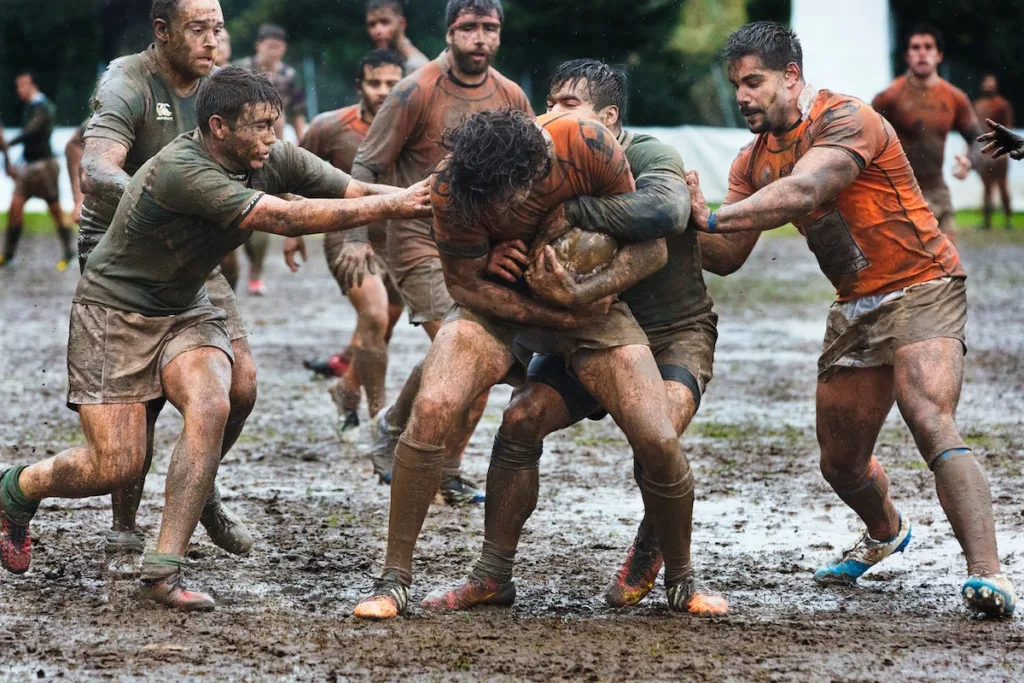Rugby is a physically demanding sport that requires a combination of strength, speed, and strategy. One of the key elements of success on the rugby field is a well-executed defensive structure. A solid defence can help teams win games, secure wins, and even turn a losing game into a victory. In this article, we will explore the basics of defensive structures in rugby and provide tips for players looking to improve their defensive skills.
Defensive structures are the plans and formations that teams use to prevent the opposition from scoring. There are several different types of defensive structures used in rugby, including a drift defence, a rush defence, and a choke defence. Each type of defence has its own strengths and weaknesses, and teams must choose the right structure to best counter the opposition’s attack.
The drift defence is a passive defence that aims to slow down the opposition’s attack by forcing them to go wide. This defence is best used when the opposition has strong runners in the center of the field. The drift defence is often used in combination with a rush defence, which is an aggressive defence that aims to disrupt the opposition’s attack by forcing them to make mistakes.
The choke defence is a containment defence that aims to force the opposition into a narrow channel, making it easier for the defence to tackle the attacking players. This defence is best used when the opposition has a strong runner in the centre of the field, or when the defence wants to limit the space available to the opposition.
Regardless of the type of defence used, all effective defensive structures in rugby have several key elements in common. These include good communication, aggressive tackling, and strong line speed. Communication is crucial in rugby, as it allows players to coordinate their efforts and make split-second decisions on the field. Aggressive tackling is also essential, as it allows the defence to stop the opposition’s attack before they can score. Finally, line speed is the key to creating pressure on the opposition, forcing them into mistakes and giving the defence a chance to win the ball.

How does a defence set up from a breakdown
In rugby, a breakdown occurs when a player is tackled and brought to the ground. The first priority of the defence at this point is to secure the ball and prevent the opposition from regaining possession. This can be achieved through a well-organised defensive structure.
Here are the steps for setting up a defence from a breakdown:
- Line speed: The defence should move up quickly to put pressure on the opposition and prevent them from getting their hands on the ball. This is known as line speed and is an important aspect of any rugby defence.
- Tackle support: Players in the defence should be ready to provide support for the tackler, either by joining the tackle or by being in position to make a follow-up tackle if necessary. This helps to ensure that the defence retains control of the ball.
- Communication: Communication is crucial in rugby, and it is especially important in the breakdown. Players should communicate with each other to coordinate their efforts and make split-second decisions.
- Rucking: Once the ball is secured, players in the defence should form a ruck by closing in on the ball and using their bodies to protect it. This helps to keep the ball in play and prevent the opposition from regaining possession.
- Marking players: The defence should also mark the opposition’s key players, such as the scrum-half, who may be looking to pick up the ball and start a counter-attack.
By following these steps, the defence can establish a strong position from a breakdown, putting pressure on the opposition and giving themselves the best chance of retaining possession of the ball. Of course, these steps must be executed quickly and efficiently, as the opposition will be looking to capitalise on any mistakes made by the defence.

What are the guard and bodyguard in rugby defence
In rugby defence, the terms “guard” and “bodyguard” refer to specific positions within a defensive structure.
The guard is the first defender in a defensive line, and their role is to protect the inside channel and prevent the opposition from making a break through the middle of the field. The guard must be quick and agile, as they are often the first defender to make contact with the attacking players.
The bodyguard, also known as the “blitz defender,” is a defender positioned behind the guard, who is responsible for providing additional support and protection to the defensive line. The bodyguard should be a strong tackler and should be prepared to make a hit on the opposition if the guard is beaten. The bodyguard should also be quick to react if the opposition makes a break through the defence, as they are often the last line of defence before the try line.
The guard and bodyguard positions are important components of a solid rugby defence, as they work together to slow down the opposition’s attack and prevent them from scoring. Effective communication between the guard and bodyguard is crucial, as it allows them to coordinate their efforts and make split-second decisions on the field. By mastering these positions, players can improve their defensive skills and help their team secure victories on the field.
What’s the difference between an “in to out” and “out to in” defence in rugby
In rugby, “in to out” and “out to in” defences refer to the direction of the defensive line relative to the attacking players.
An “in to out” defence is when the defensive line moves from the inside of the field towards the touchlines, in an effort to push the attacking players towards the sidelines. This type of defence aims to limit the space available to the attacking players and force them to go wide, where they are more likely to make a mistake. An “in to out” defence is often used when the opposition has strong runners in the centre of the field, as it helps to slow them down and prevent them from making a break through the middle.
An “out to in” defence is when the defensive line moves from the touchlines towards the centre of the field, in an effort to cut off the attacking players’ options and force them into a narrow channel. This type of defence is best used when the opposition has a strong runner in the centre of the field, or when the defence wants to limit the space available to the attacking players. An “out to in” defence is an aggressive defence that aims to disrupt the opposition’s attack by forcing them to make mistakes.
Both “in to out” and “out to in” defences have their own strengths and weaknesses, and teams must choose the right defence to best counter the opposition’s attack. Effective communication and line speed are important components of any rugby defence, regardless of whether it is an “in to out” or “out to in” defence. By mastering these defensive strategies, players can improve their defensive skills and help their team secure victories on the field.
How do you train for specific defensive structures
Training for specific defensive structures in rugby requires a combination of physical and mental preparation. Here are some tips for training for different defensive structures:
- Communication: Communication is crucial in rugby, and it is especially important in defence. Teams should practise communicating with each other on the field, both in drills and in scrimmage situations, to improve their ability to coordinate their efforts and make split-second decisions.
- Tackle drills: Tackle drills are an important part of any rugby training program, and they are especially important for players looking to improve their defensive skills. Teams should practise making tackles in a variety of situations, including one-on-one tackles, support tackles, and tackles in broken-field situations.
- Line speed drills: Line speed is a key component of any rugby defence, and teams should practise moving up quickly to put pressure on the opposition. This can be done through a variety of drills, such as blitz drills, where players move up quickly to tackle a dummy or a coach acting as the attacking player.
- Scrimmage situations: Scrimmage situations are a great way to simulate game conditions and practise different defensive structures. Teams should practise different defensive structures in scrimmage situations, including “in to out” and “out to in” defences, and should focus on executing the defence quickly and efficiently.
- Video analysis: Video analysis can be a valuable tool for teams looking to improve their defensive skills. Teams should watch game footage to see how different defensive structures are executed in real game situations, and to identify areas for improvement.
By incorporating these training techniques into their preparation, teams can improve their ability to execute specific defensive structures in rugby, and help their team secure victories on the field. Of course, the specific training program will vary depending on the team’s needs, but these tips can provide a good starting point for teams looking to improve their defensive skills.
In conclusion, defensive structures are an essential component of rugby success. By understanding the basics of drift, rush, and choke defences, players can improve their defensive skills and help their team secure victories on the field. Whether you’re a beginner or an experienced player, taking the time to learn and master these defensive structures will pay dividends in your rugby career.

